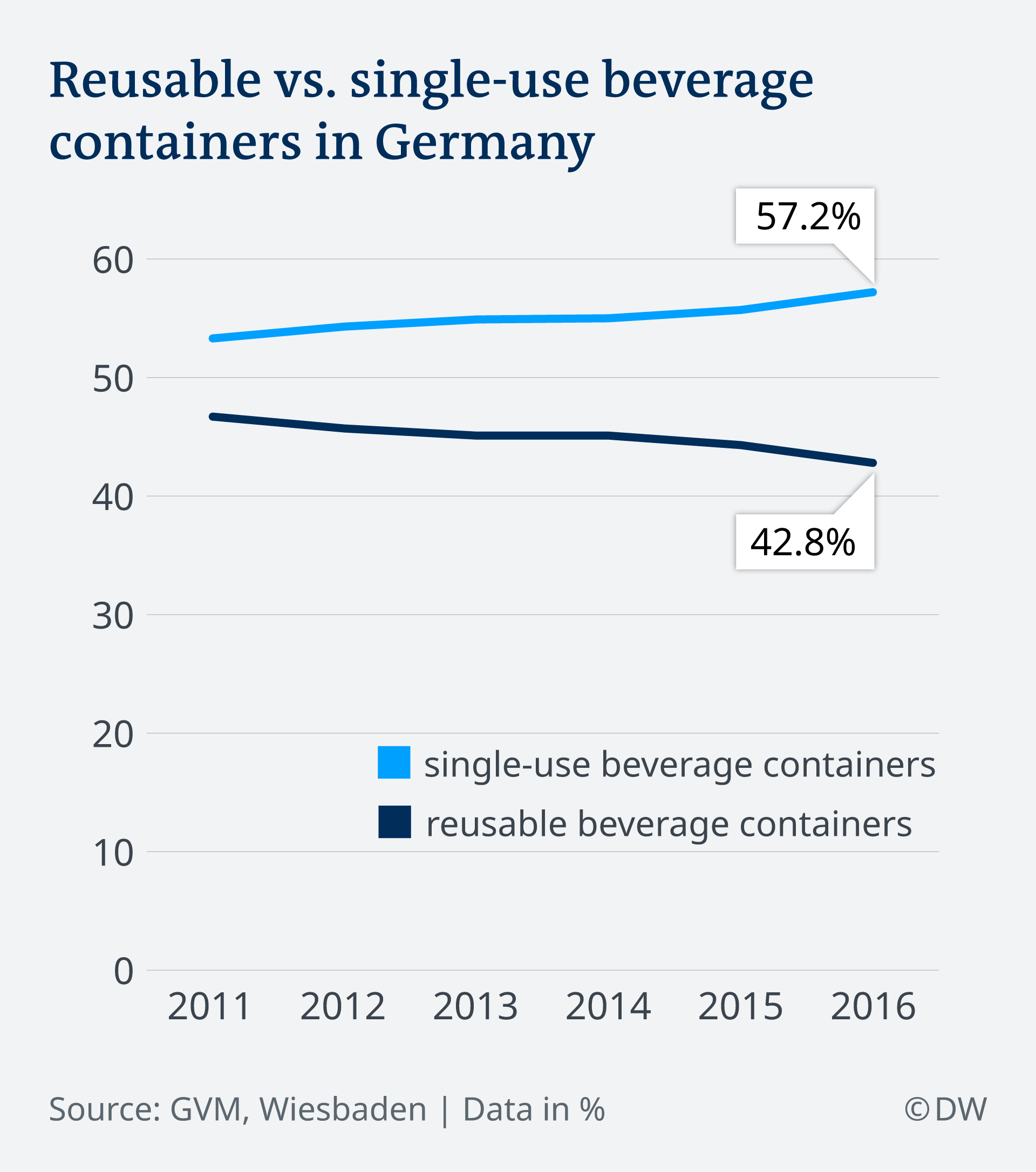| Law Summary | ORDINANCE ON THE AVOIDANCE OF PACKAGING WASTE makes manufacturers responsible for taking back the packaging of their products and sets targets for refilling and recycling rates. |
| Date Implemented | 1/1/2003(Packaging ordinance was passed 7/1/1991, but container deposits were not put into effect until 2003; later updated in 2023) |
| Containers Covered | Glass, aluminum, and plastic drink containers between 100mL to 3L. [1] |
| Beverages Covered |
|
| Amount of Deposit |
|
| Reclamation System |
Return to retail |
| Program Success |
No redemption rate is available to evaluate the success of Germany’s program since beverage sales and returns data are not collected by a single agency. |
Details
Germany’s bottle deposit system is administered through the German Packaging Act (VerpackG). The previous 1991 deposit law, known as the Packaging Ordinance, was amended in 2019. The Deutsche Pfandsystem GmbH (DPG) is a non-profit that acts as a neutral overseer of the DRS.
Missing Redemption Rate Explained
This page previously reported that the German program had a 98% redemption rate, but it has since been discovered that the 98% rate was in a single report that described a portion of the system, and that report is no longer available. It is now known that no single agency in Germany collects data on how many beverage containers are sold and redeemed each year. Therefore, a redemption rate cannot be calculated. DPG confirmed with CRI that redemption rates are not calculated in Germany because the information is not collected (personal communication, October 2023).
Multiple studies also erroneously mislabel the share of recycled materials as a redemption rate. One highly cited example is GVM’s 2019 study looking at the yield rate for PET bottles of 94%. This 94% number is then misconstrued as a 94% redemption rate for PET bottles in Germany.
In order for a redemption rate to be calculated in Germany to analyze the success of its program, an agency must collect all beverage container sales and redemption data. Ideally, the sales and redemption data would be confirmed through audits. Currently, DPG assumes no liability for the accuracy of the data it receives from the redemption operators.
Further Details
The packaging act was amended in 2021 to expand coverage to these beverages, between 0.1-3.0 liters, that were previously exempt: sparkling wine, mixed sparkling wine drinks, wine and mixed wine drinks, wine-like drinks and mixed drinks, alcohol products, other mixed drinks containing alcohol, fruit and vegetable juices, and non-carbonated fruit and vegetable nectars. Beginning in 2024, milk drinks and dietary beverages for young children, as well as other milk beverages in disposable plastic bottles, are also included under the law. [4] On May 25, 2021, the German Packaging Ordinance was further amended to include PET juice bottles. [5] Participation in the deposit system is mandatory.
Originally, retailers were only required to take back the brands that they sell, but the law was amended in 2004 to require them to take back all containers that are made of the same material as containers they sell. [6] While the law also requires distributors and manufacturers to accept and recycle or reuse returned packaging for other products, there is no deposit charged on these other materials. Rather, the manufacturers fund the system by paying fees to product stewardship organizations. [7]
Historically, another provision in the Packaging Ordinance requires the beverage industry to maintain a minimum level of refillable containers, which for beer, soft drinks, fruit juice, mineral water and wine is 72% (milk 17%). If the levels are not maintained, the government was to set mandatory deposits. After the passage of the law the market share of refillables rose to 75% but fell below the required 72% between 1997 and 2000. [8] This has been correlated with a decrease in refillable containers in the market, though refillable containers make up a significant portion of the beverage market in Germany. [9] Refillables are exempt from the Packaging Ordinance, but carry voluntary deposits between 0.08-0.15 EUR. There is currently no universal labeling for refillable bottles, though there is for single-use bottles. [10]

Figure: Percentage of Single-Use Versus Reusable Beverage Containers in Germany (2011-2016). Source: DW's "How does Germany's bottle deposit scheme work?"
Footnotes
[1] "Law on the placing on the market, taking back and high-quality recycling of packaging (Packaging Act - VerpackG)." The Federal Ministry of Justice, the Federal Office of Justice. July 5, 2017, last amended May 11, 2023.
[2] "Expansion of deposit obligations as of 1 January 2022." Deutsche Pfandsystem GmbH. September 1, 2021.
[3] "How do I distinguish between single-use or reusable beverage packaging?" Deutsche Pfandsystem GmbH. August 1, 2021.
[4] see Footnote 2.
[5] “German parliament approves packaging law extension to PET juice bottles, KHS offers recycling solutions.” Packaging Insights. May 26, 2021.
[6] "Evaluating End-of-Life Beverage Container Management Systems for California." Morawski, Clarissa. R3 Consulting Group. May 15, 2009.
[7] "A look at Germany’s bottle deposit scheme.” Ruiz, Irene and Cwienk, Jeanette. Deutsche Welle (DW). November 11, 2021.
[8] Report by the Government of the Federal Republic of Germany on the implementation of the compulsory deposit for one-way drinks packaging by October 2003. Germany Environmental Agency. October 2003.
[9] see Footnote 7.
[10] see Footnote 7.
Last Updated on January 4, 2024.